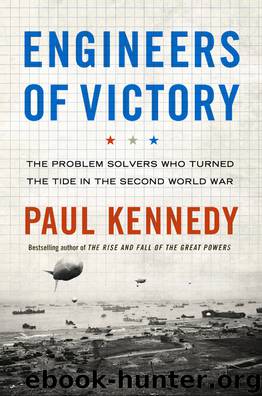Engineers of Victory: The Problem Solvers Who Turned the Tide in the Second World War by Paul Kennedy

Author:Paul Kennedy [Kennedy, Paul]
Language: eng
Format: epub
Tags: General, History, Political Science, Technology & Engineering, International Relations, Military, World War II, Marine & Naval
ISBN: 9781588368980
Publisher: Random House
Published: 2013-01-29T00:00:00+00:00
a The term blitzkrieg gets used, often sloppily, to cover different though related things. Literally, it translates as “lightning war.” As such, it could be applied to many campaigns (that of Frederick the Great; Israel’s 1967 fighting), although the word popularly arose to describe the so-called German way in warfare in 1939–41—fast battleground movements by armored and motorized infantry units to take the enemy’s army off guard, sometimes followed by a pulling back to regroup and then strike again. German tactical airpower (dive-bombers, medium-range bombers) gave it a new touch. It has nothing in common with the London Blitz of 1940–41 (although obviously the Luftwaffe was once again to the fore), which was a lengthy aerial bombing campaign against the capital city.
b Witzig and Otto Skorzeny (whose daring raid captured Mussolini and brought him out of captivity) compete for being the model for the Michael Caine character (a paratroop colonel who fought in the Low Countries, Crete, and Russia) in the celebrated novel and movie The Eagle Has Landed.
c As this chapter unfolds, it will be clear that the standard units of military size—army groups, divisions, brigades, regiments, battalions, et cetera—only help us a small way in understanding the effective power of one protagonist vis-à-vis another in a campaign. American divisions were huge; Soviet divisions were half their size. German divisions on the Eastern Front had shrunk to one-quarter of their size by 1944, but Hitler still insisted on calling them divisions. Tank numbers were similarly confusing; if it took four or five T-34s to knock out a Panther during the 1943 Battle of Kursk, what did raw numbers matter? The same was true in the naval balances, though in a reverse form—British cruisers and destroyers were far better balanced in the North Atlantic than their massive, top-heavy German equivalents, which yawed so much that their crews became seasick.
d It is hard to extricate this word from the German language: the literal meaning is “cauldron battle,” though in practice it was understood to involve an outflanking move, a breakthrough, an encirclement, and, in its highest form, a pincer movement that fully enclosed the enemy’s army and compelled its surrender. The ghosts of the ancient Battle of Cannae, and of the recent Schlieffen Plan, haunted this operational dream.
e Frustrated at Auchinleck’s caution even after receiving so many reinforcements, Churchill sent him off to India. His successor, Gott, was killed unexpectedly in an air crash, and Bernard Montgomery was then placed in charge of the Eighth Army. He himself was almost as cautious as Auchinleck, and his chief achievement hitherto had been his careful management of the retreat of his division toward and through Dunkirk in 1940. After Alamein, however, Montgomery became the popular symbol of the restored glory of British generalship.
f Hence the continuing calls by Libya and Egypt for the British, German, and Italian governments to take steps to have millions of these wartime mines destroyed, since they continue to cause casualties among local civilians and their animals, make oil exploration dangerous, and even deter tourism.
Download
This site does not store any files on its server. We only index and link to content provided by other sites. Please contact the content providers to delete copyright contents if any and email us, we'll remove relevant links or contents immediately.
Learning SQL by Alan Beaulieu(6235)
Weapons of Math Destruction by Cathy O'Neil(6206)
Digital Minimalism by Cal Newport;(5700)
iGen by Jean M. Twenge(5384)
Sapiens by Yuval Noah Harari(5321)
The Age of Surveillance Capitalism by Shoshana Zuboff(4243)
Elon Musk by Ashlee Vance(4082)
Thing Explainer by Randall Munroe(3905)
Apollo 8 by Jeffrey Kluger(3664)
Future Crimes by Marc Goodman(3558)
The Science Book (Big Ideas Simply Explained) by DK(3251)
Who Can You Trust? by Rachel Botsman(3110)
The Innovators: How a Group of Hackers, Geniuses, and Geeks Created the Digital Revolution by Walter Isaacson(2979)
I Live in the Future & Here's How It Works by Nick Bilton(2958)
Infinite Energy Technologies by Finley Eversole(2952)
Steve Jobs by Walter Isaacson(2855)
Dawn of the New Everything by Jaron Lanier(2751)
Chernobyl by Serhii Plokhy(2514)
Ben Franklin's Almanac by Candace Fleming(2492)
